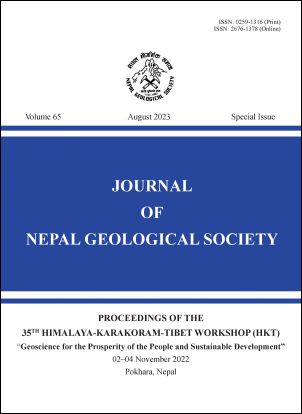Stability assessment of desander cut slope of Seti Khola Hydropower Project
DOI:
https://doi.org/10.3126/jngs.v65i01.57747Keywords:
Discontinuity properties, 3D model, groundwater, earthquake, shear strength, stability assessmentAbstract
Due to steep topography in the Himalaya, opening space for the development of infrastructures involves excavation of hillside slopes which possesses certain degree of risk associated with failure. This paper aims to assess the stability of the rock slope excavated for the placement of desander basin of the Seti Khola Hydropower Project (22 MW) located in Lekhnath, Kaski district of Gandaki Province. The height of the cut slope is about 60 m and is the challenging part of the construction work of this project. The slope is cut in the rock mass belonging to highly schistose graphitic phyllite intercalated with meta-sandstone at the upper part of the slope. To conduct a detailed stability assessment, the discontinuities, and geometric characteristics have been evaluated by field mapping. A three dimensional (3D) geological model has been generated to represent the geometric properties of discontinuities and the cut slope incorporating failure plane. The mechanical characteristic of the intact rock is established through literature review whereas the rock mass properties have been assessed using different equations. Rock mass quality has been assessed by using Rock Mass Rating (RMR) method of rock mass classification. RMR values are then correlated into Slope Mass Rating (SMR) incorporating different factors of slopes as per the site conditions. Further, kinematic analysis has been carried out using geometric and discontinuity properties to evaluate the structurally controlled failure. The influence of groundwater and earthquake has been considered while determining the shear strength of sliding surface. Finally, stability assessments have been carried out empirically, analytically and two dimensional (2D) numerical modelling.
Downloads
Downloads
Published
How to Cite
Issue
Section
License
© Nepal Geological Society




